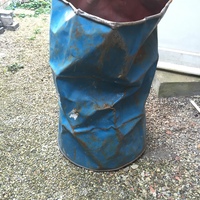Dr Ben Parry
Bath Spa University, Bath School of Art and Design, Department Member
- Dr Ben Parry is a visual artist based in London. He received his BA in Environmental art from Glasgow School of Art an MCD in Urban Planning from University of Liverpool and PhD from University of West of Scotland. He is co-founder of ar... moreDr Ben Parry is a visual artist based in London. He received his BA in Environmental art from Glasgow School of Art an MCD in Urban Planning from University of Liverpool and PhD from University of West of Scotland. He is co-founder of arts organisation Jump Ship Rat through which he curates and produces exhibitions, site-specific projects and unsanctioned interventions in the public realm. His research and practice explores the role of interventionism and activism in challenging the urbanization of neoliberalism with a focus on reclaiming urban space. He is editor of the book Cultural Hijack: rethinking intervention (2012 Liverpool University Press), an anthology of experimental approaches to situation-led urban interventions and in 2013 curated Cultural Hijack exhibition at the Architectural Association, London, on the same theme. Working under the International Peripatetic Sculptors Society (IPSS) he is regularly invited to conduct action-based workshops fusing the Situationist tradition of derive with the creation of spontaneous interventions.edit
In this chapter I open up an alternative framework to understand and interpret waste aesthetics and the ethics of waste, through the lens of art and its embeddedness in ideas of biopolitics. The works I use to illustrate a proposed theory... more
In this chapter I open up an alternative framework to understand and interpret waste aesthetics and the ethics of waste, through the lens of art and its embeddedness in ideas of biopolitics. The works I use to illustrate a
proposed theory of subaltern realism – necessarily born in and through struggle – aim to provide answers to the following questions: How
should we make sense of our encounters with politically engaged social art practices (beyond the institution) in the context of unequal development? And what theoretical, conceptual and interpretive tools might help to untangle the complex politics of representation/self representation
of subaltern narratives, which are further problematised by the institutional framing and power relations of art (and academia) itself?
proposed theory of subaltern realism – necessarily born in and through struggle – aim to provide answers to the following questions: How
should we make sense of our encounters with politically engaged social art practices (beyond the institution) in the context of unequal development? And what theoretical, conceptual and interpretive tools might help to untangle the complex politics of representation/self representation
of subaltern narratives, which are further problematised by the institutional framing and power relations of art (and academia) itself?
Research Interests:
Cultural Hijack explores our unforeseen encounters with creative action in the sites and situations of the urban everyday. These interventions and disruptions of habitual behaviours and perceptions by the anomalous and the out-of-place... more
Cultural Hijack explores our unforeseen encounters with creative action in the sites and situations of the urban everyday. These interventions and disruptions of habitual behaviours and perceptions by the anomalous and the out-of-place challenge us in radical ways to rethink our relationship to the urban environment. Cultural Hijack positions the artist as narrator, revealing the thinking behind interventions as well as the process of their creation and reception, to expose the ways in which the city becomes the playground, stage and instrument for unsanctioned artworks, informal creative practices, activist interventions and overtly political actions.
publisher: Liverpool University Press, 2011
editors: Ben Parry, Sally Medley, Myriam Tahir
Contributors: Michael Rakowitz; Gelitin; Nina Edge; BGL; Kryzstof Wodiczko; Peter McCaughey; Tatzu Nishi; Myriam Tahir; Yabon Paname; Pavel Buchler
publisher: Liverpool University Press, 2011
editors: Ben Parry, Sally Medley, Myriam Tahir
Contributors: Michael Rakowitz; Gelitin; Nina Edge; BGL; Kryzstof Wodiczko; Peter McCaughey; Tatzu Nishi; Myriam Tahir; Yabon Paname; Pavel Buchler
Research Interests:
This chapter discusses the multidisciplinary project Autoconstrucción by Mexican artist Abraham Cruzvillegas, which relates the story of his childhood through the self-build construction of his family home on the volcanic lands of the... more
This chapter discusses the multidisciplinary project Autoconstrucción by Mexican artist Abraham Cruzvillegas, which relates the story of his childhood through the self-build construction of his family home on the volcanic lands of the Pedregales de Coyoacan outside Mexico City. The first in a series of realizations for Autoconstrucción began far from the precarious spaces of Mexico City, when Abraham Cruzvillegas took up a 6-month residency at Cove Park and the Centre for Contemporary Arts in Glasgow in 2008. During that time, the artist created his customary sculptures of found-objects, produced a book documenting his experiences growing up on squatted lands of the Ajusco, and wrote the lyrics for 18 songs that were then offered to a diverse range of local Glaswegian bands. An in-depth analysis of this particular aspect of the project is explored, which extends into a broader discussion about the wider contribution of social art practice in the critical discourses around urban informality and user-generated urbanisms. It also explores how the personal experiences of self-build, self-organized communities have formed the methodology of Cruzvillegas’s social practice, artistic sensibility, aesthetics, poetics and politics that raise critical challenges to current debates around precariousness in art.
